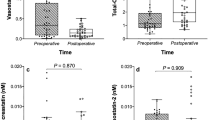Abstract
Background: Chromogranin A (CgA) is considered the most accurate marker in the diagnosis of gastro-entero-pancreatic (GEP) endocrine tumors. Pancreatic polypeptide (PP) has also been proposed to play this role, but then not used due to its low sensitivity. The aim of the present study was to determine whether the assessment of PP would improve the diagnostic reliability of CgA in patients with GEP tumors. Patients and methods: Both markers were assessed in 68 patients [28 functioning (F), 40 non functioning (NF)]. Twenty-seven patients disease-free (DF) after surgery, and 24 with non-endocrine tumors (non-ETs) were used as control groups. Results: CgA sensitivity was: 96% in F, 75% in NF, 74% in pancreatic, and 91% in gastrointestinal (GI) tumors. Specificity was 89% vs DF, and 63% vs non- ETs. PP sensitivity was: 54% in F, 57% in NF, 63% in pancreatic, and 53% in GI tumors. Specificity was 81% vs DF, and 67% vs non-ETs. By combining the two markers a significant gain in sensitivity vs CgA alone was obtained: overall in GEP tumors (96% vs 84%, p=0.04), in NF (95% vs 75%, p=0.02), and in pancreatic (94% vs 74%, p=0.04). More specifically, a 25% gain of sensitivity was obtained in the subgroup of NF pancreatic tumors (93% vs 68%, p=0.04). Conclusion: The combined assessment of PP and CgA leads to a significant increase in sensitivity in the diagnosis of GEP tumors, particularly in pancreatic NF.
Similar content being viewed by others
References
Eriksson B, Arnberg H, Lindgren PG, et al. Neuroendocrine pancreatic tumors: clinical presentation, biochemical and histopathological findings in 84 patients. J Int Med 1990, 228: 103–13.
Corleto VD, Panzuto F, Falconi M, et al. Digestive neuroendocrine tumours: diagnosis and treatment in Italy. A survey by the Oncology Study Section of the Italian Society of Gastroenterology (SIGE). Dig Liver Dis 2001, 33: 217–21.
Oberg K, Janson ET, Eriksson B. Tumor markers in neuroendocrine tumors. Ital J Gastroenterol Hepatol 1999, 31 (Suppl. 2): S160–2.
Kim T, Tao-cheng JH, Eiden LE, Loh YP. Chromogranin A, an “On/Off” switch controlling dense-core secretory granule biogenesis. Cell 2001, 106: 499–509.
Nobels FR, Kwekkeboom DJ, Coopmans W, et al. Chromogranin A as serum marker for neuro-endocrine neoplasia: comparison with neuron-specific enolase and the a-subunit of glycoprotein hormones. J Clin Endocrino Metab 1998, 82: 2622–8.
Baudin E, Gigliotti A, Ducreux M, et al. Neuron-specific enolase and chromogranin A as markers of neuroendocrine tumors. Br J Cancer 1998, 78: 1102–7.
Bajetta E, Ferrari L, Martinetti A, et al. Chromogranin A, neuron specific enolase, carcinoembryonic antigen, and hydroxyndole acetic acid evaluation in patients with neuroendocrine tumors. Cancer 1999, 86: 858–65.
Goebel S, Serrano J, Yu F, Gibril F, Venzon DJ, Jensen RT. Prospective study of the value of serum chromogranin A or serum gastrin levels in the assessment of the presence, extent, or growth of gastrinomas Cancer 1999, 85: 1470–83.
Janson ET, Holmberg L, Stridsberg M, et al. Carcinoid tumors: analysis of prognostic factors and survival in 301 patients from a referral center Ann Oncol 1997, 8: 685–90.
Tomassetti P, Migliori M, Simoni P, et al. Diagnostic value of plasmatic chromogranin A in neuroendocrine tumors. Eur J Gastroenterol Hepatol 2001, 13: 55–8.
Adrian TE, Bloom SR, Bryant MG, Polak JM, Heitz PH, Barnes AJ. Distribution and release of human pancreatic polypeptide. Gut 1976, 17: 940–4.
Bloom SR, Adrian TE, Polak JM. Pancreatic polypeptide from pancreatic endocrine tumors. Lancet 1980, 2: 1026.
Oberg K, Grimelius L, Lundqvist G, Lorelius LE. Update on pancreatic polypeptide as a specific marker for endocrine tumors of the pancreas and gut. Acta Med Scand 1981, 210: 145–52.
Panzuto F, Falconi M, Nasoni S, et al. Helical computed tomography and somatostatin receptor scintigraphy on staging of digestive endocrine tumours. Ann Oncol 2003, 14: 586–91.
Adrian TE, Uttenthal LO, Williams SJ, Bloom SR. Secretion of pancreatic polypeptide in patients with pancreatic endocrine tumors. N Engl J Med 1986, 315: 287–91.
Baudin E, Bidart JM, Bachelot A, et al. Impact of Chromogranin A measurement in the work-up of neuroendocrine tumors. Ann Oncol 2001, 12 (Suppl 2): S79–82.
Weber HC, Venzon DJ, Lin JT, et al. Determinants of metastatic rate and survival in patients with Zollinger-Ellison syndrome: a prospective long-term study. Gastroenterology 1995, 108: 1637–49.
Schurmann G, Raeth U, Wiedenmann B, Buhr H, Herfarth C. Serum chromogranin A in the diagnosis and follow-up of neuroendocrine tumors of the gastroenteropancreatic tract. World J Surg 1992, 16: 697–701.
Stabile BE, Howard TJ, Passaro E Jr, O’Connor DT. Source of plasma chromogranin A elevation in gastrinoma patients. Arch Surg 1990, 125: 451–3.
De Bruine AP, Wiggers T, Beek C, et al. Endocrine cells in colorectal adenocarcinomas: incidence, hormone profile and prognostic relevance. Int J Cancer 1993, 54: 765–71.
Stivanello M, Berruti A, Torta M, et al. Circulating chromogranin A in the assessment of patients with neuroendocrine tumors. A single institution experience. Ann Oncol 2001, 12 (Suppl 2): S73–7.
Leone N, Pellicano R, Brunello F, Pizzetto M, Ponzetto A. Elevated serum chromogranin A in patients with hepatocellular carcinoma. Clin Exp Med 2002, 2: 119–23.
Author information
Authors and Affiliations
Corresponding author
Rights and permissions
About this article
Cite this article
Panzuto, F., Severi, C., Cannizzaro, R. et al. Utility of combined use of plasma levels of chromogranin A and pancreatic polypeptide in the diagnosis of gastrointestinal and pancreatic endocrine tumors. J Endocrinol Invest 27, 6–11 (2004). https://doi.org/10.1007/BF03350903
Accepted:
Published:
Issue Date:
DOI: https://doi.org/10.1007/BF03350903




